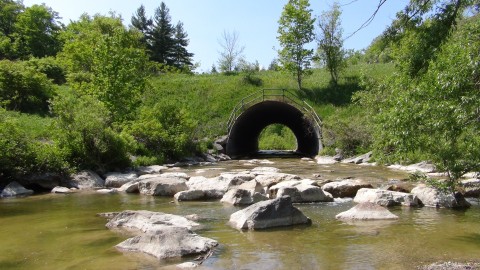Valley and Stream Corridor Crossings Guideline
The impact of urban expansion on the local environment can be linked to numerous human practices. One such practice is the construction of road and railway crossings over streams and valleys, which have a substantial impact on the habitat and wildlife connectivity in a watershed. Today, there are over 3,500 bridges and culvert crossings within Toronto and Region Conservation Authority (TRCA) watersheds and the number is expected to grow, as many crossings will be added, upgraded or reconstructed to accommodate population growth and accompanying transportation network needs. Improperly designed crossing structures can have a negative impact on the ability to mitigate natural hazards and to preserve natural heritage features.
From a natural hazard perspective, improperly designed crossing structures can:
- Impede the flow of floodwaters, creating increases in flooding upstream of crossings or creating conditions in which roadways are flooded
- Come into contact with river and stream channels as they migrate across the floodplain over time, causing major damage of failure of the crossing infrastructure (i.e. footings, abutments, piers)
- Be damaged by valley slope failure if constructed in an inappropriate locations or with inadequate countermeasures
- Destabilized slopes during construction resulting in risks to adjacent land uses
From a natural heritage perspective, improperly designed crossing structures can:
- Impede the movement of fish species upstream and downstream, particularly during migration or other critical life stages
- Prevent the movement of terrestrial animals up and down valley corridors, fragmenting populations and often forcing animals onto roadways where they are killed by cars and create a public safety hazard
- Fragment high quality aquatic and terrestrial habitat, decreasing its quality and ability to support healthy populations of native and sensitive species
To address the needs to mitigate the effect of evolving urban infrastructure on habitat and wildlife, TRCA has developed a set of guidelines for road-watercourse crossings. These guidelines incorporate the latest science to balance ecological benefits with economic costs, while fulfilling mandated responsibilities for the management of flooding and erosion hazards. The guidelines indicate that sufficiently sized and appropriately sited and designed crossings can mitigate many of the impacts of the natural function of corridors and on the broader natural heritage system. To aid in this, the Guideline articulates TRCA study requirements for the review of proposed new crossings and upgrades to existing crossings (extension, repair, replacements) from preliminary concepts and alignments, to intermediate planning stages, through to detailed design.

